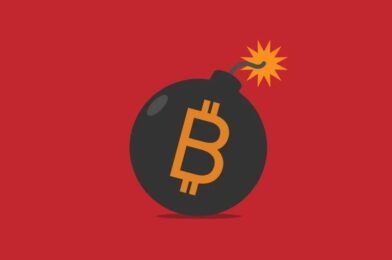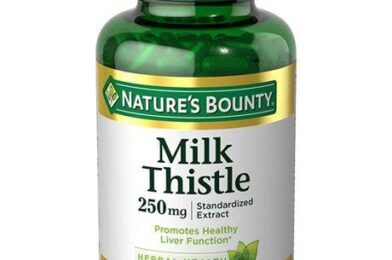Have you been looking for a natural boost to overall health? Then you might have already researched the incredible benefits of milk thistle.
Milk thistle is a powerful health supplement typically taken orally and used to treat various health issues, which is a significant factor for milk thistle gaining popularity in treating multiple disorders like fatty liver disease.
So if you’re considering buying milk thistle supplements to treat your health problems, but don’t know what to look for, then you’re in the right place. This guide will go through the 7 best milk thistle supplements, benefits, potential side effects, and FAQs section.
** This post may contain affiliate ads where we make a small commission on purchases made at no cost to you. We only recommend products we think you will find valuable.**
7 Best Milk Thistle Supplements
- Best Overall Milk Thistle Supplement: Bronson Milk Thistle
- Runner-Up Best Milk Thistle Supplement: Nature’s Bounty Milk Thistle
- Best Budget Milk Thistle Supplement: Jarrow Formulas Milk Thistle
- Best Combination Milk Thistle Supplement: Natures Craft Milk Thistle
- Best High Strength Milk Thistle Supplement: NOW Supplements Milk Thistle
- Best Liquid Milk Thistle Supplement: Nature’s Answer Milk Thistle
- Best Milk Thistle Supplement For Liver: OmniBiotics Milk Thistle
1. Best Overall Milk Thistle Supplement: Bronson Milk Thistle
Bronson Vitamins has been a pioneer in the supplement space since the 1960s and is considered a high-quality brand by medical professionals. Bronson’s milk thistle extract is a powerful antioxidant that is fortified with dandelion root.
Each capsule contains 1000 mg of milk thistle and 50 mg of dandelion root; with 120 capsules per bottle, you will get four months of benefits. Bronson believes that their highly potent milk thistle supplement can help maintain healthy liver function, remove unwanted toxins, and convert nutrients into substances the body can use.
The supplement was formulated using the highest quality ingredients in a cGMP-certified facility and is constantly lab-tested to ensure quality and potency. Bronson recommends taking one capsule daily with meals or as instructed by your healthcare professional.
Pros
- +Great value
- +GMO, Gluten, and Soy-Free
- +Includes dandelion root
- +Reputable brand
Cons
- –Avoid if allergic to ragweed or daisy-like flowers
Each capsule contains 1,000mg of milk thistle to provide high-power liver support…
2. Runner-Up Best Milk Thistle Supplement: Nature’s Bounty Milk Thistle
Nature’s Bounty has been creating herbal products for over forty years that are backed by science and made with only the purest ingredients. Rather than standard milk thistle capsules, Nature’s Bounty Milk Thistle supplement utilizes rapid-release soft gels to support liver health.
The soft gels are designed to disperse quickly into your system, supporting liver function and waste elimination. Nature’s Bounty recommends taking one soft gel capsule up to three times daily to see the best results.
There are 200 capsules per bottle, each serving containing 250 mg of milk thistle extract. Nature’s Bounty Milk Thistle supplement is certified non-GMO and free of artificial flavors, sweeteners, and preservatives.
It also contains no milk, soy, gluten, wheat, fish, and sodium, so most people should be able to take this supplement. In addition, Nature’s Bounty products are manufactured in state-of-the-art facilities that meet the FDA’s current Good Manufacturing Practices to ensure safe and effective products.
Pros
- +High quality
- +No unwanted fillers
- +Made in the USA
- +Laboratory tested
Cons
- –Contains no additional ingredients
Nature’s Bounty Milk Thistle Dietary Supplements provide 250mg of milk thistle powder per capsule…
3. Best Budget Milk Thistle Supplement: Jarrow Formulas Milk Thistle
Jarrow Formulas aims to help people achieve optimal health with high-quality, effective, affordable, and superior formulations of dietary supplements. Their milk thistle product is a highly-concentrated formula that has been standardized to 30:1, which means it yields 80% of total flavonoids.
Each bottle contains 100 capsules, each serving size containing 150mg of milk thistle seed extract. According to its product page, the capsules are veggie, which makes them suitable for vegans and vegetarians.
The brand suggests taking milk thistle one to three times daily to boost immune response, produce antioxidants and free radical scavenging activity, and induce positive liver-protecting benefits. The supplement is made in cGMP-compliant facilities in the USA, which enables the company to test its product quality and potency from start to finish.
Pros
- +30:1 concentrated formula
- +Vegan and vegetarian friendly
- +Reasonable price
- +Superior formulation
- +Gluten-free
Jarrow Formulas’ liver support formulas include botanical extracts, herbal formulas, supplements…
4. Best Combination Milk Thistle Supplement: Natures Craft Milk Thistle
Natures Craft Detox and Repair Formula is a fantastic herbal supplement with Milk Thistle, Dandelion Root, Organic Turmeric, Artichoke Extract, and other helpful ingredients. Natures Craft products use cruelty-free, non-GMO botanical ingredients and are formulated in American GMP facilities.
Each batch is rigorously tested in certified third-party laboratories and uses globally sourced ingredients. Inside each bottle, you’ll receive 30 servings of two capsules.
Not only can this milk thistle supplement help with liver function, but it can also improve energy levels, help maintain weight, and improve gut wellness. The brand recommends taking two capsules, one daily, 20-30 minutes before a meal, with water.
Pros
- +Unique blend
- +Premium quality
- +Made in world-class laboratories
- +Multiple benefits inside one bottle
Cons
- –Some users may also experience side effects such as migraines
- –It has a proprietary blend
Natures Craft products use cruelty free non GMO botanical ingredients and are formulated in American GMP facilities…
5. Best High Strength Milk Thistle Supplement: NOW Supplements Milk Thistle
Now Supplements Double Strength Silymarin has twice the milk thistle extract as many of its competitors. This vegetarian formula also includes a generous dose of artichoke and dandelion for additional support.
One veggie capsule has 300 mg per capsule, with each bottle containing 200 capsules. A highly concentrated milk thistle supplement can aid with better absorption, bioavailability, and more potent liver support.
Now Supplements takes great pride in ensuring its milk thistle product is Soy Free, Non-GMO, Vegan, Nut Free, Glut, Dairy Free, Egg Free, Halal, and Kosher.
They also hold an A-rated GMP certification, meaning that every aspect of the NOW manufacturing and laboratory process has been examined for proper stability, potency, and product formulation.
Pros
- +Family-owned and operated company since 1968
- +GMP Quality Assured
- +Most people should be able to take this
- +Double strength
- +Great reviews
Cons
- –Some people may not need double strength
All aspects of the NOW manufacturing process have been examined ensuring quality, including our laboratory/testing methods…
6. Best Liquid Milk Thistle Supplement: Nature’s Answer Milk Thistle
Nature’s Answer Milk Thistle Extract is a fantastic liquid supplement that promotes liver cleansing and function. Each bottle provides you with 30 servings, with each serving containing 2,000mg of pure milk thistle seed extract. This means that the milk thistle extract is at a 1:1 dry herb equivalent.
To preserve its bioavailability and quality, Nature’s Answer Milk Thistle Extract undergoes an extensive process of “cold extractioning,” which allows the raw materials to be extracted without heat exposure.
Nature’s Answer believes it can be absorbed faster than traditional capsules or tablets by taking milk thistle extract in liquid form. The supplement is made in the USA and is free of alcohol and gluten, non-GMO verified, and holistically balanced.
Nature’s Answer adds vegetable glycerin at the end of the manufacturing process to ensure shelf stability. Nature’s Answer recommends taking 1 – 2ml (roughly 28-60 drops) daily with water for best results.
Pros
- +Super concentrated
- +High-quality ingredients
- +Cold extraction technique
- +Family-owned company
- +Alcohol-free
Super concentrated 2,000 mg of pure milk thistle extract promotes healthy liver function, detoxification…
7. Best Milk Thistle Supplement For Liver: OmniBiotics Milk Thistle
OmniBiotics Organic Milk Thistle utilizes a powerful 4x concentrate and was developed with an effective, proprietary seed extraction method. Combining these two factors results in one of the most potent milk thistle supplements on the market.
Inside each bottle, you’ll receive 120 capsules, with each capsule having 375mg of organic milk thistle seed extract equal to 1,500mg of raw milk thistle. According to OmniBiotics, having a higher concentration of milk thistle is required for maximum absorption.
OmniBiotics put their milk thistle supplements through an in-depth qualification process to be certified organic by CCOF. In fact, every ingredient in the capsule is 1005 organic and is sourced from within the USA.
The clinical-strength organic supplement is entirely natural and free of gluten, animal by-products, artificial ingredients, chemicals, preservatives, and unwanted fillers. OmniBiotics recommends taking one capsule daily with a meal to see the best results.
Pros
- +Pure, organic ingredients
- +Extra strength
- +Vegan-friendly
- +Fantastic reviews
Cons
- –One of the more expensive options
OmniBiotics milk thistle supplement contains 50% MORE silymarin milk thistle extract in each capsule as compared…
What is Milk Thistle?
Milk thistle is an annual flowering herb related to the ragweed and daisy family. It is a native herb typically found in Mediterranean countries.
Sometimes it is also called Mary thistle or Holy Thistle. This prickly herb has distinct purple flowers and white veins. The most common active ingredients are a group of plant compounds collectively known as Silymarin.
The most common milk thistle herbal remedy is commonly known as milk thistle extract. Milk thistle extract has a naturally high level of Silymarin, usually between 65–80%, which is a concentrate from the plant.
The Silymarin extracted from milk thistle has been shown to have potent antioxidant, antiviral, and anti-inflammatory properties. Traditionally milk thistle has been used to treat gallbladder and liver issues, improve brain function, prevent and treat cancer, and maintain bone density.

Benefits of Milk Thistle:
There are numerous health benefits of taking a milk thistle supplement. Let’s look at some of the proven benefits of taking milk thistle below.
1. Liver Protection
Milk thistle is commonly promoted for its incredible liver-protecting effects. Four out of six studies showed significant improvements in at least one liver function. People who suffer from liver diseases and have taken a milk thistle supplement have shown reductions in liver inflammation and liver damage due to alcoholic and non-alcoholic liver disease, hepatitis, and liver cancer¹.
2. Improve Brain Function
Milk thistle has recently been reported to be a putative neuroprotective agent against many neurologic diseases, including Alzheimer’s, Parkinson’s, and cerebral ischemia². Its anti-inflammatory and antioxidant qualities mean that it is also beneficial for its neuroprotective properties and how it can help prevent the decline in brain function as you age.
Silymarin, found in milk thistle, also exhibits the potential to recover psychomotor and cognitive abnormalities.
3. Maintain Bone Density
Recently, Silymarin has received attention due to its alternative beneficial effect towards improving and maintaining bone formation. This is because it is a mixture of flavonoids with powerful antioxidant properties.
These factors can modulate multiple genes in favor of helping to build bone and prevent bone loss. As a result, researchers suggest that milk thistle can be a helpful therapy for preventing or delaying bone loss and regulating osteogenesis³.
4. Improve Cancer Treatments
Some research suggests that the antioxidant effects of Silymarin can have some anticancer effects⁴, which can be beneficial for people receiving cancer treatment. Silymarin can also play a unique role by reducing the toxic effects on vital organs or healthy cells.
Side-effects
There are currently no known severe side effects of Silymarin or any other enzyme of milk thistle, but results can vary from person to person. The only adverse effects known are typically due to having an allergic reaction to one or more enzymes found in milk thistle.
The most commonly reported side effects include a gentle gastrointestinal disturbance, mild allergic reactions, urticaria, nausea, headache, joint pain, itching, and mild laxative symptoms. Therefore, we recommend consuming or supplementing milk thistle after consulting your primary healthcare provider.

What to look for when buying Milk Thistle:
When shopping for the best milk thistle supplement online there are a number of factors to consider before making your final decision. Have a look at the vital aspects you should be aware of.
1. Ingredients
Milk thistle comes in a couple of different forms and concentrations, but most clinically dosed milk thistle supplements have used extracts at a dose of about 200 mg, which can be taken two or three times per day.
As with many herbal supplements, there’s not a uniformly agreed-upon daily recommended dosage, as it can vary for each person. The most significant active ingredient in milk thistle extract is Silymarin.
You’ll want to ensure Silymarin is mentioned to get the maximum benefits from a milk thistle supplement. Some milk thistle makers include various natural ingredients, which can aid with additional liver support.
These additional ingredients to look out for are Dandelion Root and Artichoke. We recommend always checking out the label to ensure nothing on the ingredient list is an allergen that you may have adverse reaction to.
2. Testing/Transparency
Another factor to look out for when researching herbal supplements is whether the product was created in certified factories and has been tested for quality. Health and wellness supplements that are high quality are typically manufactured in FDA-approved and GMP-certified facilities, with most products manufactured in such facilities being reliable and safe for consumption.
Many herb supplement brands claim that their milk thistle products are naturally produced and safe for consumption. However, what proof do they have to back up their claims?
Third-party testing and certifications allow the consumers to go through lab reports for products and ensure that the ingredients are safe for consumption and are appropriately dosed for full effectiveness. For a health supplement to be considered good, the brand should be transparent about its ingredients, its manufacturing processes, and extraction methods.
3. Price
Some milk thistle supplements can become costly due to the process of production, marketing, and other factors not related to their product quality. When looking at the price when shopping for milk thistle supplements, you put a higher consideration for the ingredients and the dosages.
Typically milk thistle supplements range in the 15-30 dollar price range.
4. Reviews
To ensure that a brand’s products are reasonable, we recommend checking out customer reviews. This is one of the best factors to ensure a brand’s reliability and effectiveness.
Milk Thistle Supplement FAQs
What is milk thistle supplement used for?
The ingredients in milk thistle supplements can work together to remove the free radicals in the body and improve bodily functions. Milk thistle can also help in improving bone density, improving cancer treatments, improving brain function, and promoting healthy liver function.
Is it OK to take Milk Thistle every day?
Milk thistle is typically considered safe for most individuals at dosages up to 420 mg, two to three times a day. Due to milk thistle being a natural herb, it is usually safe to take on a daily basis.
If you start to experience unwanted side effects, stop taking milk thistle.
Who should not take Milk Thistle?
Milk thistle supplements should not be taken by women that are pregnant or breastfeeding. People with a history of hormone-related cancers, which includes breast, uterine, and prostate cancer, should also try to avoid taking milk thistle.
If you have allergic reactions to ragweed, chrysanthemums, marigolds, chamomile, yarrow, or daisies, you will most likely experience unwanted side effects and should avoid taking supplements with milk thistle.
Is milk thistle good for working out?
There are various uses for milk thistle extracts, but it is commonly used by bodybuilders to keep the liver healthy to improve muscle growth and strength. Milk thistle helps to replenish the liver cells and promotes liver detox to remove free radicals and toxins.
Bodybuilders who are taking PED (performance-enhancing drugs) can put the liver and other organs under considerable stress, resulting in damaged cells. Silymarin helps to reduce these effects.
How long does milk thistle take to kick in?
Depending on the reason you are taking milk thistle, the time it takes to kick in varies. If you are taking it as an emergency antidote due to poisoning by death cap mushrooms, it can take as little as ten minutes to start working.
For other benefits, it can take roughly two to four weeks to start seeing positive changes.

Summary
This in-depth article for the best milk thistle supplements will help you choose the best one according to your needs. Milk thistle supplements promote detoxification, improve liver function, maintain bone density, improve brain function, and can aid cancer treatments.
You can’t go wrong with whichever milk thistle supplement you choose on our list, as all 7 are the best options on the market. If you have any questions, post them in the comments below!






